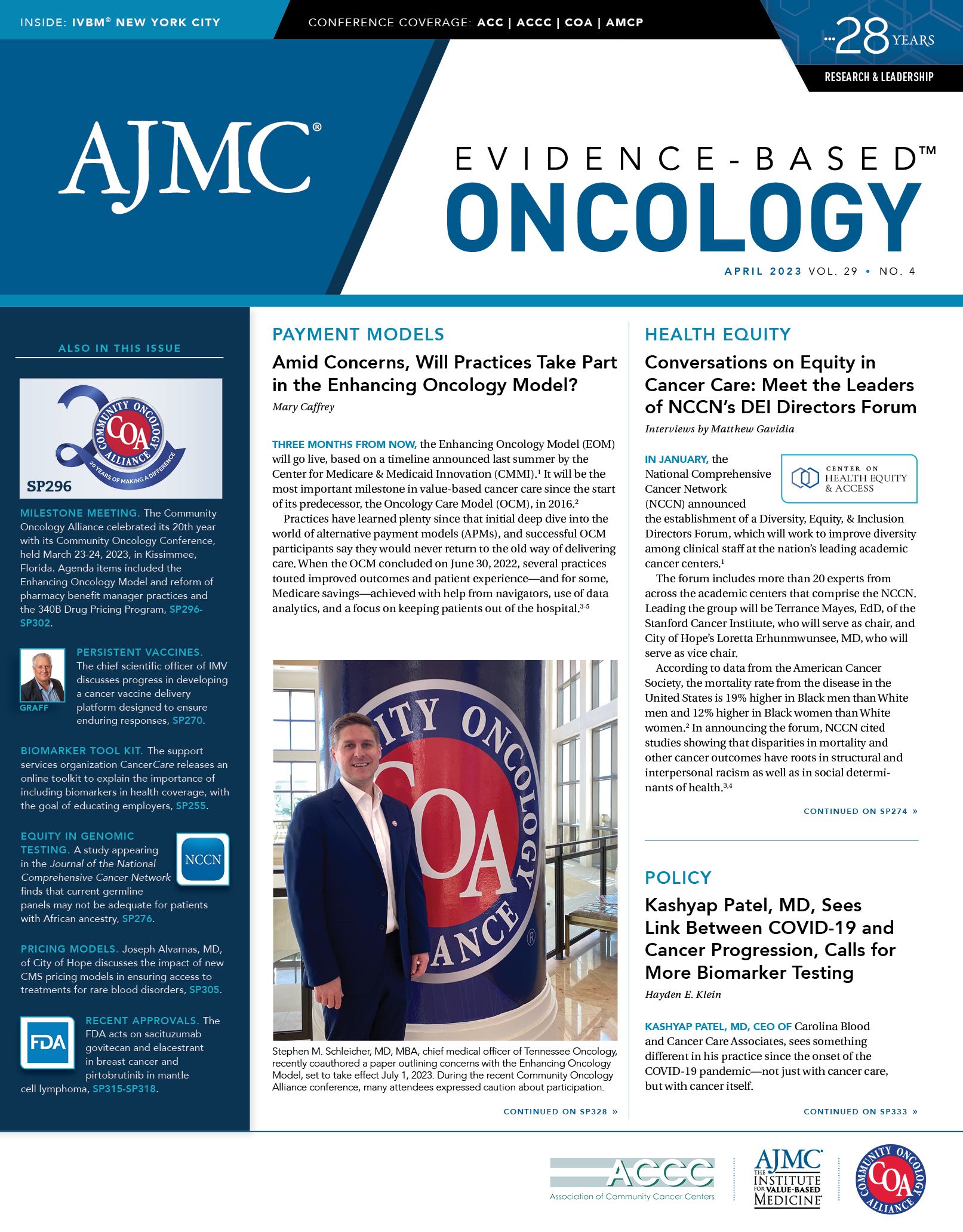- Center on Health Equity & Access
- Clinical
- Health Care Cost
- Health Care Delivery
- Insurance
- Policy
- Technology
- Value-Based Care
Clinical Updates: Spring 2023
Results for ribociclib, ponatinib, brexucabtagene autoleucel, and allo-HCT.
Topline Results Show Phase 3 NATALEE Trial of Ribociclib Meets End Point in Early Breast Cancer
Novartis announced March 27 that the phase 3 NATALEE trial evaluating its CDK4/6 inhibitor ribociclib (Kisqali) in early breast cancer had met its primary end point in this pivotal study. Results will be presented at an upcoming scientific meeting and submitted to FDA and to regulatory agencies in other countries, according to the company’s statement.
NATALEE enrolled patients with stage II and stage III HR+/HER2- early breast cancer (EBC), regardless of nodal involvement. Patients in the study drug arm were given ribociclib alongside endocrine therapy for 3 years.
The primary end point, invasive disease-free survival, measures whether a patient’s cancer has returned. According to a statement from Novartis, ribociclib plus endocrine therapy significantly reduced the risk of disease recurrence compared with standard endocrine therapy alone in the adjuvant setting.
Officials from Novartis said NATALEE represents the broadest patient population of any CDK4/6 inhibitor trial to date. EBC represents more than 90% of patients with breast cancer; 30% to 60% of the patient population represented in the NATALEE trial currently remains at risk of breast cancer recurrence with endocrine therapy only.
Slamon

“While most patients are diagnosed and treated early with the aim to cure breast cancer, the risk of cancer returning, often as metastatic disease, peaks within 3 years after diagnosis, but never goes away completely,” Dennis J. Slamon, MD, the lead investigator and director of Clinical/Translational Research for the University of California, Los Angeles Jonsson Comprehensive Cancer Center, said in the statement.
“There is a critical need for new, well-tolerated options that keep patients cancer-free without disrupting quality of life,” he said. “It is extremely encouraging that this study met its primary endpoint.” The NATALEE study protocol calls for ongoing follow-up to evaluate long-term outcomes, including overall survival.
Reference
Novartis’ Kisqali Phase III NATALEE trial meets primary endpoint at interim analysis demonstrating clinically meaningful benefit in broad population of patients with early breast cancer. News release. Novartis. March 27, 2023. Accessed March 27, 2023. http://bit.ly/42TWUCr
Ponatinib Demonstrates Increased Efficacy vs Imatinib in Patients With Ph+ALL
The phase 3 open-label PhALLCON trial found ponatinib (Iclusig; Takeda) plus chemotherapy to be more effective than imatinib with chemotherapy in patients with Philadelphia chromosome–positive acute lymphoblastic leukemia (Ph+ALL), according to results presented February 15, 2023, during the American Society of Clinical Oncology (ASCO) Plenary Series.
BCR::ABL1 tyrosine kinase inhibitors (TKIs) are the standard of care for newly diagnosed Ph+ALL, but patients treated with first- or second-generation TKIs often develop resistance to treatment. Ponatinib, a third-generation TKI, was directly compared with the first-generation TKI imatinib for the first time in PhALLCON (NCT03589326), according to an ASCO news release.
A total of 245 adult patients were randomized to receive either ponatinib or imatinib, with both cohorts also receiving reduced-intensity chemotherapy. At the data collection cutoff, 78 patients in the overall cohort were still receiving treatment. Among these patients, 41% were receiving ponatinib and 12% were receiving imatinib.
After a 12-week induction period, the proportion of patients with no detectable residual disease was 34.4% in the ponatinib group compared with 16.7% in the imatinib cohort (P = .0021). Event-free survival was not reached in the ponatinib group but was trending toward improvement at time of data cutoff.
“These results provide confirmation that ponatinib plus chemotherapy is an effective, safe treatment option for individuals with Ph+ALL, an aggressive acute leukemia with a historically poor outcome,” Olatoyosi Odenike, MD, ASCO expert in leukemia and director of the leukemia program at UChicago Medicine in Illinois, said in a statement. “Future research comparing ponatinib to a second-generation TKI would help determine the best choice of TKI for these patients. Chemotherapy-free regimens incorporating TKIs in combination with antibody-based therapies are being actively investigated in this disease.”
Hematopoietic stem cell transplantation, adverse events (AEs), and inefficacy were the most common reasons for treatment discontinuation among trial participants. In both groups, AEs and arterial occlusive events were similar.
Jabbour

“The potential benefit to patients who achieve this early deep response may be important to improve long-term survival outcomes,” lead author Elias Jabbour, MD, from The University of Texas MD Anderson Cancer Center in Houston, said in the statement. “The trial results indicate ponatinib as a potential standard of care for patients newly diagnosed with Ph+ALL.”
Reference
Ponatinib more effective than imatinib for newly diagnosed Ph+ALL leukemia patients. News release. American Society of Clinical Oncology. February 14, 2023. Accessed February 14, 2023. http://bit.ly/41q7ArE
Brexucabtagene Autoleucel Shows High Rate of Durable Response at 3 Years
Three-year follow-up results of chimeric antigen receptor (CAR) T-cell therapy brexucabtagene autoleucel (Tecartus) in adults with relapsed/refractory B-cell acute lymphoblastic leukemia (R/R B-ALL) demonstrated high rates of durable response and a median overall survival of 26 months, according to results released February 9, 2023.
The rate of complete remission (CR) or CR with incomplete hematologic recovery (CRi) was 71% and the CR rate was 56%, according to a statement. Results came from the pivotal ZUMA-3 study (NCT02614066); the findings were presented during a poster session at the 5th European CAR T-cell Meeting in Rotterdam, the Netherlands, according to drug manufacturer Kite.1
The safety profile was found to be consistent since the 2-year analysis.
In October 2021, the FDA approved brexucabtagene autoleucel for adult patients diagnosed with R/R B-ALL.2
“For adult patients living with ALL, there is a need for therapeutic options that provide long-term responses,” Bijal Shah, MD, MS, ZUMA-3 investigator and medical oncologist at the Moffitt Cancer Center in Tampa, Florida, said in a statement.1 “The continued durable response and significant improvement in survival indicated by these new data can potentially establish a new standard of care for adult patients living with this aggressive form of leukemia.”
ZUMA-3 is an ongoing phase 1/2 study of brexucabtagene autoleucel in adult patients with ALL whose disease is refractory to or has relapsed following standard systemic therapy or hematopoietic stem cell transplantation.
In the phase 2 treated patient cohort (n = 55), the median follow-up was 38.8 months (range, 32.7-44.6). The OS rate at 36.0 months was 47.1% (95% CI, 32.7%-60.2%), with a median OS of 26.0 months among all treated phase 2 patients (n = 55) and 38.9 months in patients with CR or CRi (n = 39).
Overall complete remission rate (CR + CRi), complete remission, and subsequent allogeneic stem cell transplant (alloSCT) rates remained unchanged since the prior data cutoff point at 71%, 56%, and 20%, respectively.
Median relapse-free survival (RFS) censored and not censored at subsequent alloSCT was 11.6 (2.7-20.5) and 11.7 (2.8-20.5) months, respectively.
For patients treated at the pivotal dose in both phase 1 and 2 (n = 78), the median follow-up at data cutoff was 41.6 months (range, 32.7-70.3). Median (95% CI) duration of response censored and not censored at subsequent alloSCT was 18.6 (9.6-24.1) and 20.0 (10.3-24.1) months, respectively.
Median RFS were both 11.7 (6.1-20.5) months.
At data cutoff, 36% of patients (28) were still alive with a median OS of 25.6 months (95% CI, 16.2-47.0) in all treated patients (n = 78).
The proportion of patients in both phases with grade 3 or higher adverse effects (AEs) was unchanged vs the prior cutoff. Additionally, there were no grade 5 AEs since the data cutoff.
Most patients in the analysis were heavily pretreated, with a median of 2 prior therapies, and 47% had received 3 or more prior therapies.
References
1. Kite’s Tecartus CAR T-cell therapy demonstrates overall survival benefit in three-year follow-up of pivotal ZUMA-3 trial in relapsed/refractory B-cell acute lymphoblastic leukemia. News release. Kite. February 9, 2023. Accessed February 9, 2023. http://bit.ly/3xc2CRk
2. FDA approves brexucabtagene autoleucel for relapsed or refractory B-cell precursor acute lymphoblastic leukemia. FDA. October 1, 2021. Accessed February 26, 2023. http://bit.ly/3mciuB1
Allo-HCT Not Linked With Better OS vs Consolidation Chemotherapy in Patients With AML in Complete Remission
Although treatment with allogeneic hematopoietic cell transplantation (allo-HCT) showed improved disease-free survival (DFS) compared with conventional consolidation chemotherapy, the findings of a randomized clinical trial suggest there may not be an overall survival (OS) benefit with allo-HCT for patients with intermediate-risk acute myeloid leukemia (AML) during first complete remission.
The findings, published in JAMA Oncology, suggest that primary allo-HCT may not improve OS compared with consolidation chemotherapy in patients with intermediate-risk AML during first complete remission (CR).
A significant proportion of patients with AML achieves CR, but the optimal treatment algorithm for intermediate-risk patients in this population is not clear, study authors noted. Although consolidation chemotherapy based on high-dose cytarabine is known to benefit patients who are lower risk during first CR, allo-HCT is an option for high-risk patients when a donor can be found. Allo-HCT carries the lowest risk of relapse but a significant risk of transplant-related mortality, and some intermediate-risk patients can still respond to allo-HCT after AML relapse, the authors said.
In the randomized phase 3, open-label, 2-armed clinical trial (NCT01246752), patients with intermediate-risk AML at 16 hospitals in Germany received either allo-HCT or high-dose cytarabine for consolidation during first CR or CR with incomplete blood cell count recovery after standard induction therapy. In the cytarabine cohort, salvage HCT was only used in case of relapse.
The main end point was 2-year OS, and secondary end points included DFS, cumulative incidence of relapse, treatment-related mortality, and quality of life.
A total of 143 patients 60 years or younger (mean age, 48.2 years) were eligible for the study and were randomized 1:1 to either treatment.
The allo-HCT group included 76 patients, and the consolidation chemotherapy group included 67 patients. In the allo-HCT cohort, 12 patients received 1 consolidation course of high-dose cytarabine to bridge until allo-HCT.
The probability of 2-year survival in the intention-to-treat analysis was 74% (95% CI, 62%-83%) after primary allo-HCT and 84% (95% CI, 73%-92%) after conventional consolidation chemotherapy (P = .22). DFS at 2 years was 69% (95% CI, 57%-80%) with allo-HCT compared with 40% (95% CI, 28%-53%) after consolidation chemotherapy (P = .001).
In the allo-HCT group, the cumulative incidence of relapse at 2 years was 20% (95% CI, 13%-31%), whereas the consolidation chemotherapy group had a cumulative incidence of relapse of 58% (95% CI, 47%-71%; P < .001) at 2 years. After primary allo-HCT, nonrelapse mortality at 2 years was 9% (95% CI, 5%-19%) vs 2% (95% CI, 0%-11%) after consolidation chemotherapy (P = .005). Both cohorts had similar health-related quality of life.
Notably, all 41 patients in the consolidation chemotherapy group who relapsed in the study subsequently underwent allo-HCT either directly or after salvage therapy.
Although patients treated with allo-HCT showed improved DFS compared with those given conventional consolidation chemotherapy, the findings suggest there may not be an OS benefit to opting for allo-HCT vs consolidation chemotherapy for patients with intermediate-risk AML during first CR.
“The results of this randomized clinical trial support the notion that patients 60 years or younger with intermediate-risk AML, as defined by Medical Research Council cytogenetic criteria, despite an improved DFS, do not benefit from allo-HCT during first CR with regard to OS,” the authors concluded. “The early identification of a suitable donor allows timely rescuing of those patients with relapse after conventional consolidation chemotherapy.”
In future research, the authors note the importance of longitudinal monitoring of residual disease dynamics in this patient population to help determine the optimal timing for allo-HCT.
Reference
Bornhäuser M, Schliemann C, Schetelig J, et al. Allogeneic hematopoietic cell transplantation vs standard consolidation chemotherapy in patients with intermediate-risk acute myeloid leukemia: a randomized clinical trial. JAMA Oncol. Published online February 9, 2023. doi:10.1001/jamaoncol.2022.7605
Study Finds Link Between Tumor Microbiome and Immunotherapy Outcomes in Soft Tissue Sarcoma
A study published in the Journal for ImmunoTherapy of Cancer found that patients with soft tissue sarcomas (STS) may have distinct, measurable intratumor microbiomes that may hold prognostic significance and potentially could be targeted in treatment.1
STS is a blanket term for cancers that form in soft tissue, including muscles, tendons, fat, nerves, and lymph and blood vessels. The gut microbiome comprises the microorganisms in the digestive tract, including bacteria, fungi, parasites, and viruses. The gut microbiome has been linked to immune function in past research, and there is increasing evidence that an intratumoral microbiome exists in some cancers, including breast, lung, pancreas, and melanoma, the study authors noted.
“Importantly, these tissues have anatomic connections with the outside world, and the question of whether there exists an intratumoral microbiome in STS, a presumed ‘sterile’ tissue, has not yet been explored in depth, despite evidence showing microbial presence in multiple solid cancers with tumor-specific predilections,” the authors wrote.
To characterize the STS tumor microbiome, the researchers sequenced DNA in tissue obtained via strict sterile biopsies from patients with nonmetastatic STS undergoing neoadjuvant radiotherapy (RT) and surgery. Stool samples were also collected at diagnosis before neoadjuvant RT, as well as after RT and before surgical resection. Control specimens were collected from surfaces that might interact with samples and from the skin microbiome of some patients to analyze for possible contamination patterns in the test specimens.
Tumor samples from 15 patients were collected for analysis, most of which were located on extremities (67%) and were histologic grade 3 (87%). At a median follow-up of 24 months, 4 patients had developed metastasis and 3 had died. More than 99% of the intratumoral DNA in the samples was found to be human, but a small amount of bacterial DNA was present in all tumors.
Bacterial DNA, including Proteobacteria, Bacteroidetes, and Firmicutes, only made up 0.02% to 0.03% of tumor DNA overall in the study. However, the proportion of bacterial DNA was consistent across samples, and this finding is significant, considering STS tissue was thought to be sterile. Viral species were also present in the samples.
“We found that soft tissue sarcomas harbor a quantifiable amount of microbiome within the tumor environment. Most importantly, we found that the amount of microbiome at diagnosis may be linked with the patient’s prognosis,” Robert J. Canter, MD, lead author of the study and chief, Division of Surgical Oncology, University of California at Davis, said in a statement.2
There was a significant positive correlation between the relative viral abundance and the infiltration of natural killer (NK) cells within the tumor tissue. NK cells are a key target for increasing immunotherapy effectiveness, the authors noted. Increased NK infiltration was linked to better overall survival and metastasis-free survival based on immunohistochemical, flow cytometry, and multiplex immunofluorescence analyses in the study.
“The study’s data show new lines of research in the paradigm-shifting concept that the microbiome of a patient and their immune system can interact and shape one another, as well as be potentially engineered to improve patient outcomes,” Canter said.
Although further research is needed to gauge the clinical impact of the study’s findings, the data suggest that the STS tumor microbiome is measurable and has potential prognostic significance.
“It has become clear that the microbiome in the gut and other parts of the body has a major impact on human health and disease,” Canter said. “Amazingly, it shapes the immune system throughout the body and, because of its interaction with the immune system, we now know it also has a big role in how the body responds to cancer and cancer treatments like immunotherapy.”
References
1. Perry LM, Cruz SM, Kleber KT, et al. Human soft tissue sarcomas harbor an intratumoral viral microbiome which is linked with natural killer cell infiltrate and prognosis. J Immunother Cancer. 2023;11(1):e004285. doi:10.1136/jitc-2021-004285
2. Tumor microbiome linked to immunotherapy success in sarcoma patients. News release. UC Davis Health. January 30, 2023. Accessed February 26, 2023. https://www.eurekalert.org/news-releases/978178

Exploring Racial, Ethnic Disparities in Cancer Care Prior Authorization Decisions
October 24th 2024On this episode of Managed Care Cast, we're talking with the author of a study published in the October 2024 issue of The American Journal of Managed Care® that explored prior authorization decisions in cancer care by race and ethnicity for commercially insured patients.
Listen
